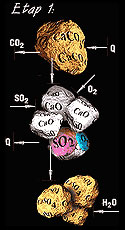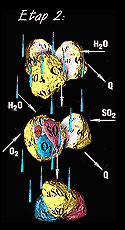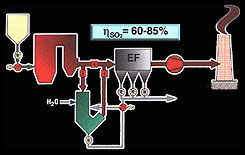OFFER
- General information
- Boiler Manufacturing Division
- Complete Power Generation Units
- Enviroment protection plants
- Oil & Gas Sector
- Metoda 200+ wg RAFAKO
- Boilers
- Waste Thermal Treatment Plants
- Services
- References
- Liquidation of stocks
Semi-dry method
FSI + Q METHOD (SEMI-DRY).
Within this method, flue gas desulfurization process is carried out in two stages.
Stage I - desulfurization process is similar to this, observed in dry method, i.e. pulverized sorbent is injected into the area with temperatures which are optimal for calcination and bonding of S02 in furnace chamber.
Stage II - flue gas desulfurization is further carried out in flue gas scrubber located between flue gas outlet from the boiler and deduster flue gas inlet.
 |
Stage I CaCO3 + DQ => CaO + CO2 |
 |
Stage II CaO + H2O => Ca(OH)2 + DQ |
Within the scrubber, due to the spraying of flue gas with water, the particles of Ca0 covered with a layer of CaS04 or CaS03 develop cracks which enable the bonding of S02 by CaO. The quantity of supplied water is adjusted so as to enable its complete evaporation. Temperature of flue gas upstream of electrostatic precipitator is reduced to the values which are safe from H2S04 condensation point of view (below dew point).

Eventually, this process promotes the increase of flue gas desulfurization efficiency. Additionally, a part of flue gas dust is precipitated in the scrubber and deposited in its lower part, from where it is removed as a process waste product.
Practically achievable flue gas desulfurization efficiency amounts to c.a. 70%, a level, which - in case of power plants fired with low combustible sulfur contents coal - gives the possibility of meeting acceptable S02 emission values.
Investment costs related with this method are higherthan in case of previous one because of the additional costs of flue gas scrubber and dust removal system. FSI + 0 method does not eliminate the disadvantages related with dry method but attenuates their effects, i.e.:
- lower increase of dust contents in flue gas upstream of electrostatic precipitator;
- reduced quantity of unused sorbent;
- increased flue gas desulfurization efficiency.
The disadvantages of this method include:
- higher investment cost (installation of scrubber and dust removal system);
- slight increase of operating costs (water supply and dust removal costs);
- increased demand for area for scrubber installation and maintenance.
Compared with the dry method: installation costs are compensated by increase of desulfurization efficiency (by 20 - 30%) and reduced emission of dust to the atmosphere due to lower dust contents in flue gas upstream of electrostatic precipitator. In 1993, RAFAKO SA was awarded with a contract for semi-dry flue gas desulfurization plant for Rybnik Power Plant (on flue gas line originating from OP - 650 boiler No. 8). The second stage of this plant, i.e. scrubber system, is based on RAFAKO SA solution, whereas the first stage, i.e. system of sorbent injection into the furnace chamber was completed by power plant service teams.